Last updated: January 16, 2025
Article
Ship Ceremonies in the Charlestown Navy Yard
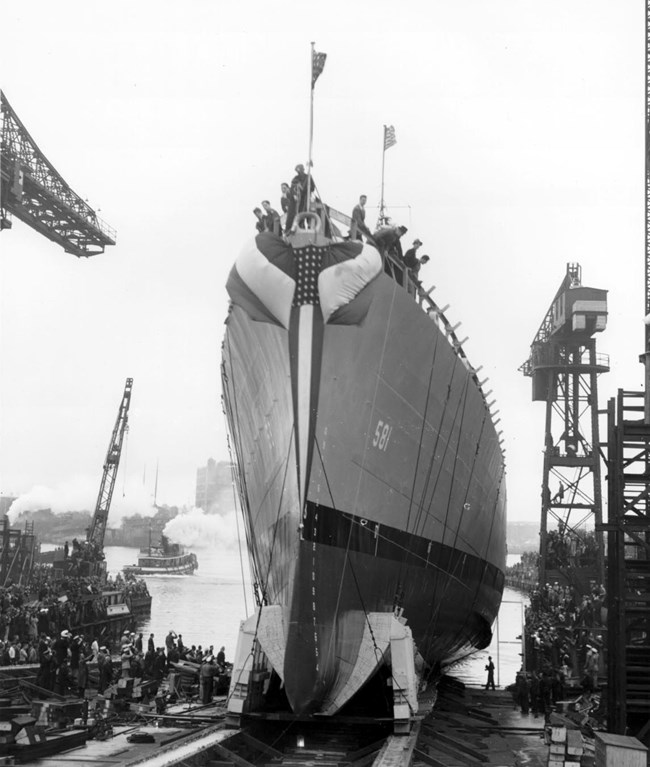
Boston National Historical Park (BNHP) BOSTS 10677-1
The life of a typical US Navy ship begins with two ceremonies, the ship's launching and the ship's commissioning. In the Charlestown Navy Yard, the Commandant of the Yard presided over these ceremonies, often accompanied by other Navy personnel, special guests, shipyard workers and the public. Boston newspapers frequently reported on these ceremonies.
As festive events, ship ceremonies in the Charlestown Navy Yard celebrated the addition of a new, often advanced ship to the US Naval fleet. Spectators cheered as civilian and Navy bands played; other Navy ships sounded their bells, whistles or horns, while sailors fired cannons and honor guards paraded. The public attended many of these ship ceremonies, except for during World War II (WWII) when the Navy closed the Yard to the public for security reasons.
Most ship ceremonies began in the Commandant's House where the Commandant and his wife served coffee to Navy officials and guests. Over the Yard's 174-year history, a ship ceremony usually attracted from two to five thousand people.


Left image
The launching US Navy ships at the Charlestown Navy Yard has been consistent over the years. The USS PRINCETON launched in 1851.
Credit: Boston National Historical Park (BNHP), BOSTS 13999
Right image
The USS FORREST launched in 1941. Most ships in the Yard were launched into the water stern first.
Credit: Boston National Historical Park (BNHP), BOSTS 11148-1239
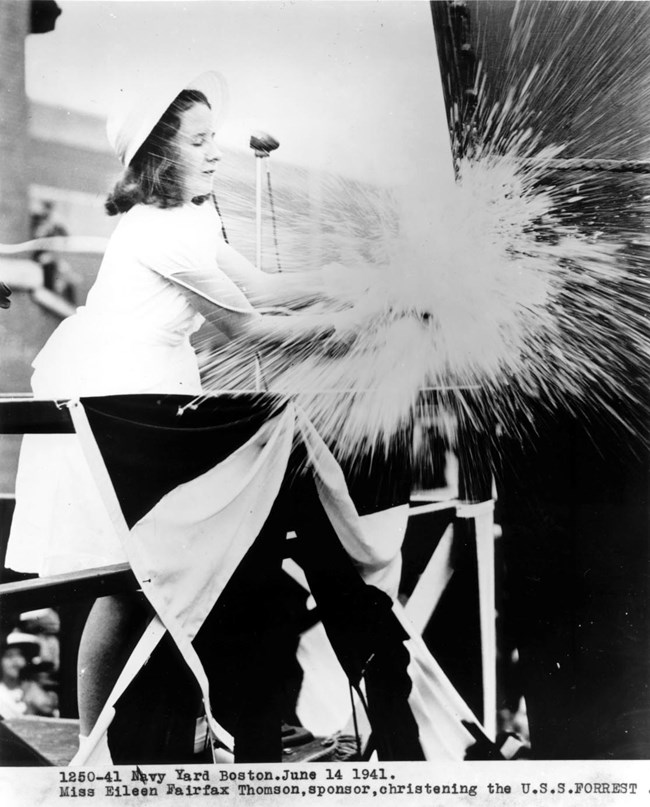
BNHP BOSTS 11148-1250
The Launching
A ship was ready for launching when Charlestown Navy Yard workers finished most of the ship and it was prepared to face its first challenge: entering the water. The launching of a ship in the Yard was a suspenseful and thrilling event.
When the Charlestown Navy Yard opened in 1800, the US Navy already had a ritual for launching ships based on centuries of European traditions. A Navy ship launching had spiritual overtones and began with an invocation by a Navy chaplain.
The christening, or naming of the ship, accompanied the launch. Historically, a woman or young girl often christened the ship by smashing a bottle of wine against the hull of the ship as she exclaimed, "I christen thee [with the name of the ship]." Workers then released the ship into the water.
The woman or young girl performing the christening is the "sponsor" of the ship and had some connection to the new ship. In the 1860s, Miss Emma Hartt, a young woman who was the daughter, granddaughter, and niece of three shipyard workers in the Charlestown Navy Yard, took part in a record three ship christenings in the Yard. During WWII, the Yard's workers gave a gift to the sponsor as a keepsake of the launching. Some sponsors received a diamond wristwatch while other sponsors received a silver bowl, both inscribed. Sponsors in the Yard's early years christened ships mostly with wine. Starting in the 1880s, Navy officials chose bottled champagne as the exclusive christening fluid.
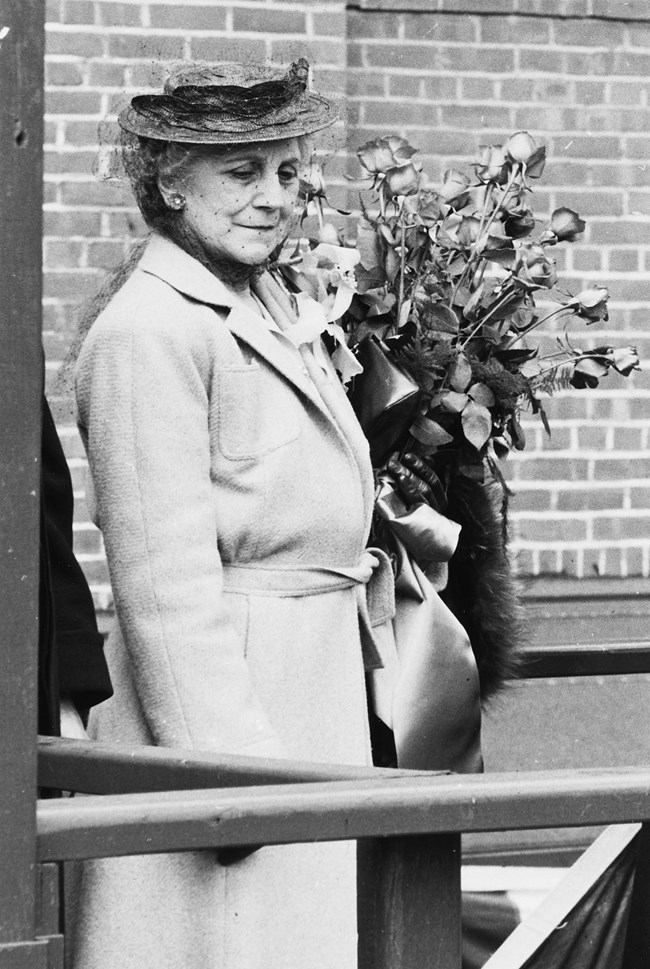
BNHP, BOSTS 10423
The Secretary of the Navy supervised the naming of US Navy ships. In the first century of the Charlestown Navy Yard, Navy officials often chose the names of American states, cities, and other places to name new ships built in the Yard. The USS Vermont, the USS Hartford, and the USS Plymouth were among those launched here. Some ships built in the Yard received place names of Native American origin: the USS Merrimack (River), the USS Wachusett (Mountain), and the USS Narragansett (Bay).
In 1897, Theodore Roosevelt as Assistant Secretary of the Navy started the tradition of naming Navy destroyers for notable Navy, Marine, and Coast Guard personnel. Starting in the 1930s, most of the ships launched or commissioned in the Charlestown Navy Yard bore the names of military personnel because the Yard specialized in destroyers. Some ship christenings were bittersweet as women christened ships named for their loved ones killed in battle.
Charlestown Navy Yard workers built ships during WWII at such a rapid rate that some ships were launched in pairs. These ships had their launches and commissioning ceremonies combined. Many of the large service ships built at this time, called LSTs, received numbers instead of names. The LSTs built in the Charlestown Navy Yard brought weapons and troops to enemy shores during WWII. Navy officials of the Yard gave the honor of christening these ships to outstanding women employees of the Yard.
After the launch, workers still had many more months of work to complete the construction of a ship depending on the ship's size and complexity. Only when the ship's crew tested the ship in a shakedown cruise was it ready for its commissioning.

BNHP, BOSTS 14331.
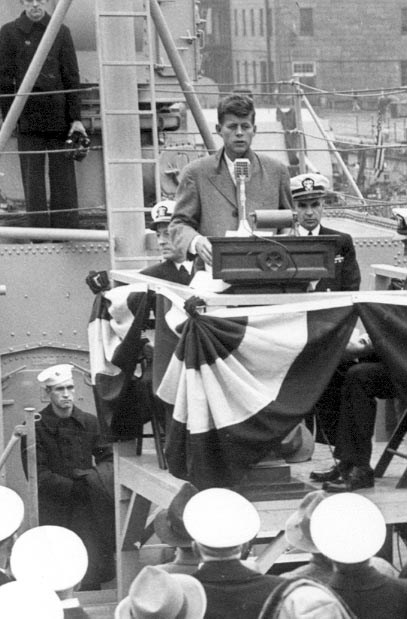
BNHP, BOSTS 10799x
The Commissioning
A ship's commissioning is more of a military event than the launch. A commissioned ship is on active duty, and the ship and its crew have a military assignment. Prior to the Civil War, commissionings were less formal, and a captain and his crew simply sailed from the Yard on their newly completed ship as the Commandant bid them farewell.
Later, commissionings in the Charlestown Navy Yard became more ceremonial. Navy officers and sometimes politicians spoke at the commissioning ceremony. The ship’s captain and crew, in full dress uniforms, stood on board the ship and were often ready to leave the Yard on their mission. The new ship flew a long, distinctive pennant flag called a commissioning pennant.
A ship didn't have to be new to get a commissioning ceremony. When shipyard workers completely overhauled a ship, Navy officials gave that ship a re-commissioning ceremony.
Over 600 ships had commissioning ceremonies in the Charlestown Navy Yard during its 174-year history. Charlestown Navy Yard workers built about a third of these ships. The Navy contracted with private yards to build the other ships; the two most productive yards were the Fore River Shipyard in Quincy, just south of Boston, and the Bath Iron Works in Maine. Some ships built in these private yards required further outfitting in the Charlestown Navy Yard. While these ships had been launched in their original shipyards, the Navy commissioned them in the Yard. Most of the ships commissioned over the lifetime of the Charlestown Navy Yard occurred during the WWII years of 1939-1945.
Unique Ship Ceremonies
Over its 174 years of ship launchings and commissionings, the Charlestown Navy Yard hosted some unconventional ship ceremonies. In 1814, the Commandant of the Yard ordered special guards around the USS Independence on launch day, fearing an attack on the new ship by the British Navy in the War of 1812. During the Civil War, Navy officials commissioned about 45 civilian ships after converting them to military use in the Yard.
In 1943, workers in the Yard launched 26 warships built for the British Navy under the Lend-Lease program; the British Navy later commissioned these ships in Britain. In the post-WWII years, the US government transferred some US Navy ships to allied foreign countries. The Commandant of the Yard and foreign dignitaries held about 45 transfer ceremonies in the Charlestown Navy Yard during the years 1950-1957.
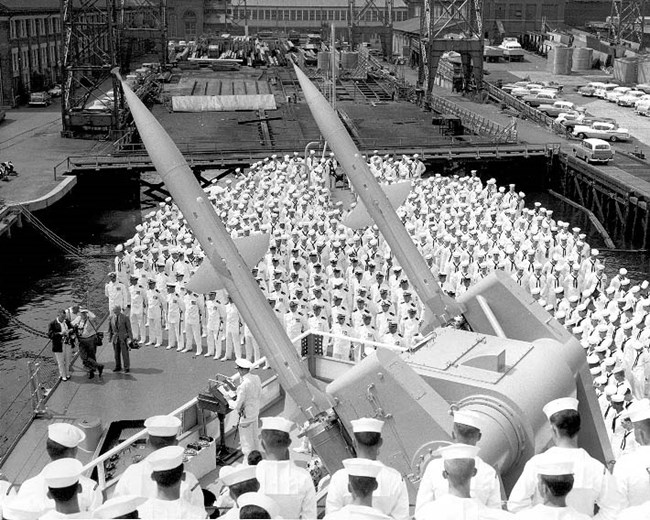
BNHP, BOSTS 14290-3.
The Legacy
During the lifetime of the Yard, workers built, repaired or updated over 6,000 vessels. Most repaired or updated ships didn't receive any ceremony when they returned to service.
From the Age of Sail to the Age of Steel, Charlestown Navy Yard officials conducted countless ship ceremonies. However, none of the ships launched or commissioned during those years are still in service. The useful life of a Navy ship is about forty years and the Yard closed in 1974. Some US Navy ships currently in service bear names that originated in the Charlestown Navy Yard: USS Vermont (2020), USS Hartford (1994), USS Tortuga (1990), and USS Bainbridge (2005). The US Navy uses recurring ship names as symbols of US Navy history and heritage. The Charlestown Navy Yard was and continues to be part of that history and heritage.
Sources
Bearss, Edwin C. Historic Resource Study: Charlestown Navy Yard, 1800-1842, Volume I and Volume II. Boston, Massachusetts: Boston National Historical Park, National Park Service, U.S. Department of the Interior, October 1984.
Bearss, Edwin C. and Frederick R. Black. The Charlestown Navy Yard 1842-1890. Boston, Massachusetts: Boston National Historical Park, National Park Service, U.S. Department of the Interior, July 1993.
Benham, Edith W. and Hall, Anne M. Ships of the United States Navy and their Sponsors 1797-1913, Privately Printed. https://archive.org/details/shipsofunitedsta01spon/page/n5/mode/2up
Black, Frederick R. Charlestown Navy Yard: 1890-1973, Volume I and Volume II. Boston, Massachusetts: Division of Cultural Resources, Boston National Historical Park, National Park Service, U.S. Department of the Interior, 1988.
Carlson, Stephen P. Charlestown Navy Yard Historic Resource Study, Vol 1-3. Boston, MA: Division of Cultural Resources, Boston National Historical Park, National Park Service, U.S. Department of the Interior, 2010.
Micholet, Margaret, A. Charlestown Navy Yard Ship Ceremonies 1939-1973. Boston, Massachusetts: Boston National Historical Park, Division of Planning and Historic Preservation,1984.
"Ship Launching and Commissioning." Naval History and Heritage Command. Accessed May 2022. https://www.history.navy.mil/research/histories/ship-histories/christening-launching-and-commissioning-of-u-s-navy-ships.html
"Ship Naming." Naval History and Heritage Command. Accessed May 2022. https://www.history.navy.mil/browse-by-topic/heritage/customs-and-traditions0/ship-naming.html
